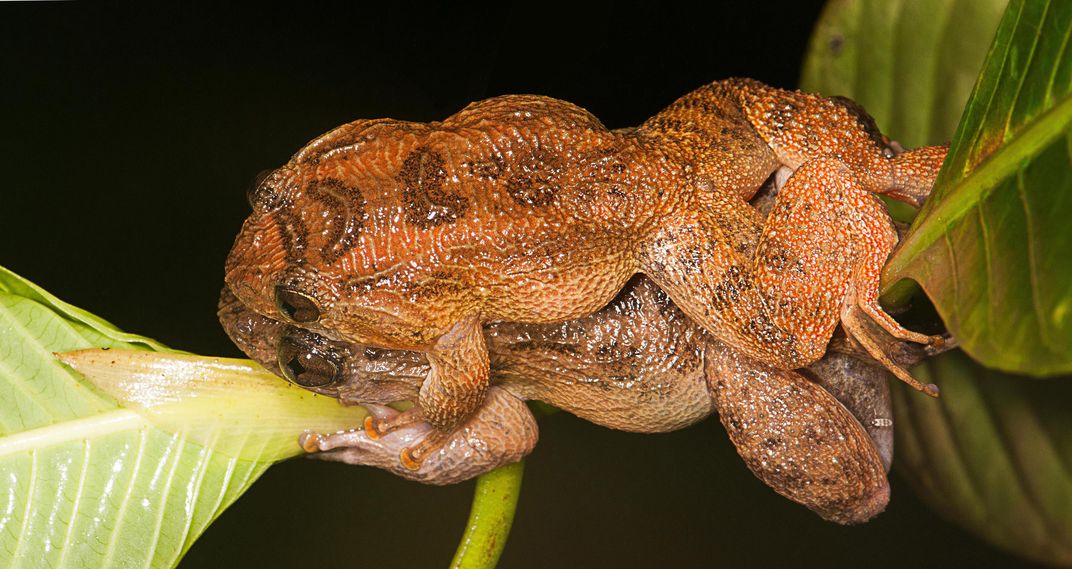The Frog Kamasutra Gains a Chapter, Thanks to Camera-Wielding Biologists
One newly described sexual position for frogs could mean one giant leap for frog conservationists
/https://tf-cmsv2-smithsonianmag-media.s3.amazonaws.com/filer/f5/38/f5383447-3949-4ec9-a763-f5ee280b7e68/peerj_press_sdb4.jpg)
Like any single male with a bachelor suite, the Bombay night frog knows that getting lucky is all about location. In India's Western Ghats mountain range, near the Koyna Lake south of Mumbai, this means a branch, leaf or rock overhanging a mountain stream. Once he sets up his seasonal abode, he’ll start calling a serenade to any nearby females moving around in the dark.
Little does he know that his overtures also attract a different species of admirer—one whose sole mission is to catch him in coitus.
“It’s a very unique experience,” says Bert Willaert, a biologist who has taken part in dozens of nightly expeditions—led by SD Biju, a frog expert at the University of Delhi—to capture the Bombay night frog’s mating habits on video. “During the monsoon it's constantly raining, so it’s very humid. These frogs are everywhere around the river,” Willaert says. But despite the volume of frogs and the sounds of the calls, actually getting footage of their escapades was a challenge.
"The difficult thing was to find a male being approached by a female,” Willaert says. But eventually the covert paparazzi tactics of Willaert and his colleagues paid off. Today, Willaert and his co-authors published a study in the open-access biomedical sciences journal PeerJ describing a hitherto unknown mating position in these frogs: the “new dorsal straddle.”
Once the female is smitten enough by a particular call, the footage revealed, she approaches the male then turns her back to him, resting her hind legs on his mouth. At this point the ball is in the male’s court. If he’s feeling the mood, he climbs on top of her. Here’s where it gets weird: Rather than getting frisky, he reaches around the female and grasps onto the stick or leaf that they are sitting on – the proverbial bed post of the Western Ghats.
This position is apparently highly unusual in the amphibian world. As far as researchers have observed — and besides Willaert there are plenty of biologists who spend a significant amount of time and resources watching amphibians mate — these are the only frog species into this kind of thing. All of the other 7,000-odd species in the world resort to only six other mating strategies. “This is quite unique from an evolutionary sense,” says Willaert, who was affiliated with the Amphibian Evolution Lab at the Free Brussels University while conducting the study.
What happens during this stage is a little unclear to Willaert and the other researchers, because their view was obscured by the wet and humid conditions of the monsoon season where they observed the mating process. But it’s likely that while the male hangs over the female, he deposits sperm on her. The female usually waits around five to 30 minutes before arching her back to send her mate off. After he leaves, she lays eggs and sits on them while the sperm trickles down and fertilizes the eggs.

The male remains nearby. Occasionally he’s so moved by the experience that he loses his balance and falls into the water, but otherwise he hangs out making territorial calls with puffed-out cheeks to ward off other males or potential predators. In fact, he will stay around well after the female leaves (the whole amorous sequence takes from half-an-hour to an hour), guarding the eggs until the tadpoles hatch and fall into the water below. While Willaert didn’t get near the frogs for fear of interrupting the process, he says that related species have even bitten other researchers in an effort to protect their eggs.
Inventive mating positions aren’t the only innovations that set this species apart. Bombay night frogs are among a small number of frog species in which the female also calls, although it’s a relatively rare occurrence. During the 40 nights that Willaert was in the field, he heard females calling only a handful of times, and managed to record the sound only once. It is difficult to tell why the females call, but Willaert thinks it might be a way to let males know they are ready to lay eggs. Or, it may simply be a way to inform males that they are nearby.
Females’ calls may have a higher frequency so they can be more easily detected over the sound of rushing water or other monsoon-season noise, says Sarah Conditt Humfeld, an associate professor of biology at the University of Missouri who has studied the ways that climate change affects the mating behavior of gray tree frogs and who was not involved in the study. The frequency characteristics of "the female call may have evolved to allow easy detection by males in this noisy environment,” she says.
Humfeld adds that the newly described mating position and female calling offer “a nice demonstration of the huge diversity of adaptations that have evolved in this ancient lineage of terrestrial vertebrates." Studies such as these point to the continuing importance of basic natural history research.
Knowing more about these frogs' mating habits could also help conservation biologists interested in breeding them for repopulation. Due to the Bombay night frog’s small and fragmented range of around 7,700 square miles, the International Union of Conservation of Nature and Natural Resources lists it as vulnerable, the category just below “endangered.” Deforestation is adding to the amphibians’ woes, says Willaert.
But while this mating strategy may be new to science, it certainly isn’t anything experimental for the animals. Indian night frogs diversified 70-80 million years ago—making the “new dorsal straddle" about as original as the missionary position.
/https://tf-cmsv2-smithsonianmag-media.s3.amazonaws.com/accounts/headshot/joshua-learn_copy.jpg)
/https://tf-cmsv2-smithsonianmag-media.s3.amazonaws.com/accounts/headshot/joshua-learn_copy.jpg)